#basal ichthyosaur
Explore tagged Tumblr posts
Text

Teleocrater takes a swim
#paleoart#speculative biology#lmao#idk how he made it to the sea#and how the basal ichthyosaur made it to Africa#teleocrater#avemetatarsalia#archosaur#not really#dinosaur#ichthyosaur#basal ichthyosaur#marine reptile#aquatic reptile#crab#not yet#lol#water#art#digital artwork#myart#bubbles ✨
36 notes
·
View notes
Text
Benggwigwishingasuchus: The Fisher Crocodile
I once again come bearing news from the realm of Pseudosuchia. Yes, we got a new taxon. Benggwigwishingasuchus eremicarminis ("Fisherman Croc's desert song") is a new basal member of the poposauroidea, a clade you might have heard about before.
But first some more key notes. Benggwigwishingasuchus has been recovered from the Anisian Fossil Hill Member of the Favret Formation, located in the US State of Nevada. It is known from a decently complete skeleton that preserves much of the neck and torso, a decent chunk of the limbs but only small pieces of the skull.
Left: Press release artwork of Benggwigwishingasuchus looking across the Panthalassan Ocean (Jorge A. Gonzalez) Right: Fossil material


As said already, Benggwigwishingasuchus is considered a member of the poposauroidea, one of the most enigmatic groups of early pseudosuchians. The reason for that is that we primarily know them from their most derived members, the bipedal Poposaurus, the sail-backed ctenosauriscids, Lotosaurus, the ornithomimosaur-mimics of the Shuvosauridae and Qianosuchus. As you can see many appear kind of like proto-dinosaurs and most have lost their osteoderm armor, requiring a whole different skeletal structure to support their erect posture. But until recent years we knew little and less about where they came from. This is thankfully starting to change now, since we now not only have Benggwigwishingasuchus, but also Schultzsuchus (formerly "Prestosuchus" loricatus) described earlier this year, Mambawakale from two years ago and recently assigned to the group as well as Mandasuchus (similar to Mambawakale originally described as something else and recently considered as a basal poposauroid). Thanks to these we are slowly starting to see a transition. Schultzsuchus still has pretty standard armour for example, but Qianosuchus shows clear signs of reduction, with Benggwigwishingasuchus kinda falling into the middle between them.
Assorted Poposauroids: clockwise from top right: Poposaurus (Skye McDavid), Arizonasaurus (Gabriel Ugueto), Lotosaurus (Gabriel Ugueto), Shuvosaurus (Joschua Knüppe)



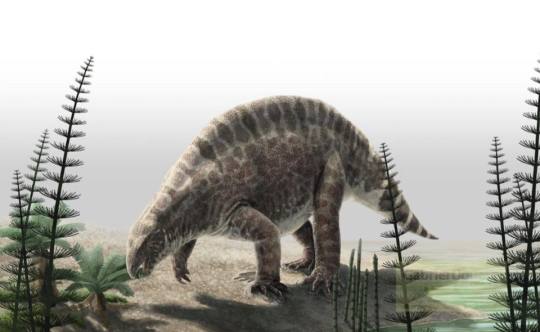
What's also interesting about Benggwigwishingasuchus is its ecology, or what little we can infer based on the circumstances of its preseration. You see, the Favret Formation preserves marine sediments and was previously best known for its ichthyosaurs (including the giant Cymbospondylus). So its kind of weird seeing a rather lanky pseudosuchian there. What's weirder still is the fact that the preservation seems to suggest that it wasn't swept out. No, its still reasonably complete, partially articulated and in the classic death pose with its back bent backwards, this thing was moved little before being burried. BUT. It wasn't marine. The skeleton fits of a terrestrial animal and both limb proportions and histology show no evidence of it being a swimmer or diver. Instead its hypothesized that it might have been an animal that inhabited the coast, possibly drawing sustenance from the sea but not actively adapted to forage in it. In this sense Benggwigwishingasuchus could parallel Ticinosuchus from Switzerland and Qianosuchus from China, both of which were coastal animals yet not explicitly aquatic (in the case of Qianosuchus it was originally proposed given its specialised tail, but recent work seems to suggest it was never very fast nor enduring).
Top image: Benggwigwishingasuchus standing on the skull of Cymbospondylus (Joschua Knüppe) Bottom left: Ticinosuchus among a group of Tanystropheus (Zach Robinson) Bottom right: Qianosuchus holding a fish (Gabriel Ugueto)



All in all, Benggwigwishingasuchus is an interesting animal that does fill in some gaps in the fossil record, both phylogentically and ecologically and though the description is sparce on actually describing the skeleton, here's hoping that more research will come out eventually. Hell, they dropped a histology on it like a day after it was named.
Wikipedia:
Benggwigwishingasuchus - Wikipedia Papers: A new pseudosuchian from the Favret Formation of Nevada reveals that archosauriforms occupied coastal regions globally during the Middle Triassic | Biology Letters (royalsocietypublishing.org)
Diverse growth rates in Triassic archosaurs—insights from a small terrestrial Middle Triassic pseudosuchian | The Science of Nature (springer.com)
#poposauroidea#benggwigwishingasuchus#favret formation#anisian#pseudosuchia#croc#prehistory#paleontology#palaeoblr#long post#paleontology news
103 notes
·
View notes
Text
More endemic fauna from Chortis


Left: Trunko (Pilosopabin cryomagister), a species of orca-sized mammutopabinid opabiniiform native to the northern oceans where they feeds on soft-bodied invertebrates, just as their ancestors have 507 million years ago.
Element: Ice
The common helechotaur (Helechotaurus champsurus) is a species of herbivorous noasaurian theropod found in forests and wetlands. They feeds primarily on ferns, mosses and fungi though they will feed on eggs and small vertebrates.
Element: Plant
The chaow (Junglopsittacus coronatus) is a species of coccatraciform maniraptoran present in certain rainforests. Unlike most of their relatives, they are nearly flightless, preferring to climb trees when confronted with predators. They are frugivores and an important part of their ecosystem.
Element: Plant/Fire
Right: Top- The sea wyrm (Hydrovorma monstrosa) is a mid-sized species of tertiarily-aquatic reptile native to the Southern Ocean where it feeds on fish. Like a few other wyrm species, it has a split jaw, enhancing its swallowing capabilities.
Element: Basic
Middle left - Icebrine wichdans (Glaciochelyops platyops), a species of large henodontiform placodont. It feeds exclusively on seagrass, which turns the fat inside its body a greenish color. The males are fully aquatic while the smaller females must crawl on land to lay eggs.
Henodontiforms are the most successful form of placodont on Chortis.
Element: Ice/Earth
Middle right - Hotshot (Ferventisaurus erythrodermis)
The hotshot is a species of basal dyptosaur, a clade of fully aquatic sauropodomorph dinosaurs similar to ichthyosaurs. Like all dyptosaurs, the hotshot is a carnivore, though it prefers to hunt aquatic tetrapods rather than fish. It has been noted that when threatened, their body temperature begins to rise sharply.
Element: Fire/Water
Bottom left - The Auroralis (Auroranektes debilitans)
The auroralis is a specialized teuthivorous dyptosaur native to the polar seas of the north. While it will eat fish or carrion, it primarily specializes in hunting belemnites and squids, making it comparable to the heavier sperm whales (which are present on Chortis).
Despite its diet of semi-soft prey, it has a lethal bite with frostbite-like symptoms. Otherwise, it is completely harmless.
Element: Ice/Dragon
Bottom right - The dwarf tusqual (Proerepatocetus meridionalis)
Tusquals are a clade of basal odontocetes that converged with walruses and odobenocetopsids (both of which are present, although only one odobenocetopsid species is extant).
They are highly intelligent suction-feeders that feed on bivalves and other shelled invertebrates. Due to their method of feeding, their necks are particularly flexible.
The dwarf tusqual is the smallest species of tusqual, being similar to size to the Hector's dolphin. They travel in pods of 20-120 individuals.
Element: Basic
#chortis: territory of magic#speculative biology#worldbuilding#creature design#speculative evolution#spectember#dinosaur#opabinia#yi qi#mosasaur#saurischian#whale
13 notes
·
View notes
Text
Life in the Early Triassic

(first row: Sclerosaurus, Lystrosaurus; second row: Hupehsuchus, Triadobatrachus, Cartorhynchus; thrid row: Rebellatrix, Atopodentatus; fourth row: Aphaneramma, Erythrosuchus)
Lystrosaurus - Julio Lacerda
Erythrosuchus - Mark Witton
Rebellatrix - Michael Skrepnick
Aphaneramma - Gabriel Ugueto
Cartorhynchus, Hupehsuchus, Atopodentatus - Nobu Tamura
Triadobatrachus - Alexey Malitskiy
Sclerosaurus - Wikimedia
We‘ve reached the Triassic period and with it the Mesozoic Era, the Age of Reptiles! Right now (about 250 million years ago), the reptiles are not dominating yet - in fact no one really was doing too well, as the Early Triassic was mostly a recovery period with low diversity after the most devastating mass extinction of all time, The Great Dying, at the end of the Permian.
The one exception to this is Lystrosaurus. The pig-sized herbivores somehow made it through the mass extinction mostly unscathed and in a now barren world they re-diversified, took up empty niches and became the most common vertebrate in many areas. It is not entirely clear why they survived. Maybe it was hibernation or burrowing that gave them some kind of protection from the worst parts of The Great Dying, maybe they were just lucky. Whatever it was, these prehistoric cockroaches marked one of the last big hurrahs of the synapsids (our own linage), before they went into hiding and lived their lifes as rodent size critters in the shadows of the reptiles for the following 200 million years or so.
The synapsids were the stars of the Permian, but only three groups of them made it into the Triassic: The carnivorous therocephalians and the herbivorous dicynodonts like Lystrosaurus with bulky bodies, mostly toothless beaks and tusk-like canines. They both went extinct during the Triassic. A third group, the cynodonts, survived much longer and will eventually include all modern mammals, from the tiniest bats to the biggest whales. But right now all of that is just some distant future.
Right now, at the beginning of the Triassic, a lot of other groups hurry to fill empty spaces. Several groups of reptiles decided that, after their ancestors once spent a lot of time and effort to evolve a terrestrial lifestyle, they want to return to the oceans. This included early cousins of the ichthyosaurs (those dolphin-shaped marine reptiles that lived alongside the dinosaurs) like Cartorhynchus and very basal sauropterygians. The most famous member of that group are the Loch-Ness-Monster-looking plesiosaurs, but one early member was the strange Atopodentatus. They possibly used their weird mouths to eat algae, making them one of the earliest herbivorous marine reptiles.
On land, the most interesting development might be the rise of the archosaurs and their close relatives. Over the span of the Mesozoic, the age of reptiles, they became the dominate group of life including many fan-favorites: The giant dinosaurs, the flying pterosaurs, the birds we have today and the wide variety of crocs, both past and present. At the beginning of the Triassic, they are just starting out, but 5 m long predators like the big-headed Erythrosuchus (although they are technically not quite archosaurs), already give a glimpse into their future.
25 notes
·
View notes
Text
Leninia stellans
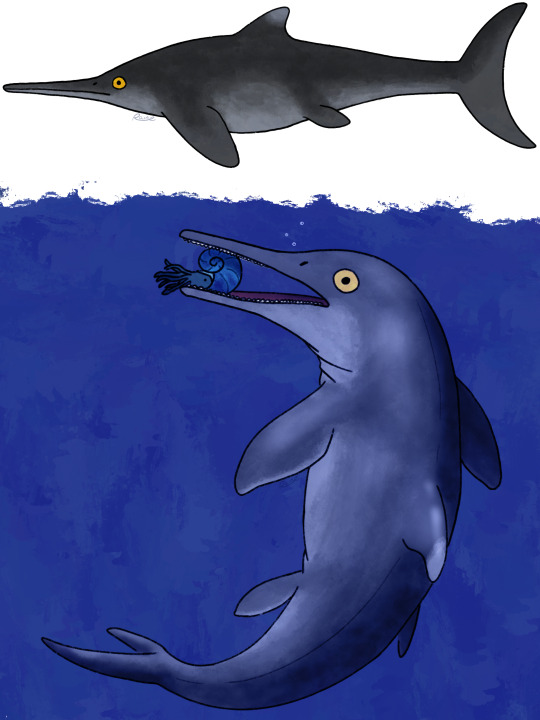
Leninia was a genus of opthalmosaurine ichthyosaur from the Early Cretaceous. Its type species is L. stellans. Its only fossil was found in the bank of the Volga river in Russia. Leninia has the third largest sclerotic ring of any known ichthyosaur, only beat by Baptanodon and Temnodontosaurus.
Leninia is indirectly named after Russian leader Vladmir Lenin, as the museum its fossil is housed in is within the Lenin Memorial and Lenin school complex in Ulyanovsk; as such, the name reflects the fossil's geohistorical location. The species name stellans refers to the fossil's star-shaped frontal-parietal suture.
Its autapomorphies include the presence of an anterior process on the prefrontal over the nasal, a frontal-parietal suture caused by forked processes on both bones, the posterior process of the maxilla extending up to the middle orbit, and the presence of a process on the supratemporal that contacts the parietal.
The only known fossil is a partial skull. It consists of the area from the back of the skull up to the naris, ending in a clean break. Leninia, while being one of the latest-living opthalmosaurines, was recovered as one of the most basal. The presence of a large sclerotic ring and apterure indicates that both are ancestral characteristics of opthalmosaurines, not derived. This also suggests that, unlike Opthalmosaurinae's sister taxon Platypterygiinae, opthalmosaurines did not diversify outside of a "deep diver" niche.
Original paper: Found here
Wikipedia article: https://en.wikipedia.org/wiki/Leninia
#reptile#reptilia#paleoart#paleontology#artwork#original artwork#human artist#leninia#opthalmosaurinae#ichthyosaur#ichthyosauria#obscure fossil animals#obscure fossil reptiles#obscure fossil tetrapods
11 notes
·
View notes
Photo

Transcript for the text on the image under the cut:
PAGE 1
Spectember 2020 #10 | nixillustration.com | alphynix.tumblr.com Concept suggested by: anonymous
Marine Temnospondyls
(Ghotiidae)
Descended from the archegosauroids, a fully aquatic group of Permian temnospondyl amphibians, the GHOTI was the closest that tetrapods ever came to actually turning back into fish.
Already retaining a rather fish-like physiology from early tetrapods, with tiny bony scales within their skin and internal gills as adults, these temnospondyls had a metabolism more like air-breathing fish than modern amphibians. While they were still facultative air-breathers using lungs to get the majority of their oxygen, their gills allowed them to stay submerged for much longer between breaths, sometimes for as much as several hours at lower levels of activity.
Like the later trematosaurids, basal ghotiids developed tolerance to saltwater and adapted to a marine predator lifestyle. But their lineage took it much further, modifying the somewhat crocodile-like body plan of their ancestors into a highly streamlined convergently ichthyosaur-like form – an ecological niche largely unexploited by tetrapods during the Permian.
Ghoti reventum, a highly derived ghotiid, reached lengths of about 4m (13'). A row of large keeled osteoderms along its spine formed a low ridge-like dorsal fin, and unlike most other temnospondyls it had polydactylous limbs with six digits each. The forelimbs formed large flippers used for steering and stabilization, and the almost vestigial paddle-like hindlimbs were kept held flush against the body, used only as "claspers" to hold onto each other during mating.
After internal fertilization and several months of development, gravid females gave live birth to litters of small larvae in shallow "nursery" waters. Just 15cm long (6"), bearing external gills and not particularly resembling their parents, these larvae didn't undergo as drastic a metamorphosis as modern amphibians do, instead only gradually changing as they grew into juveniles and then adults over the course of around 20 years.
[Image: a small axolotl-like larval amphibian with a blunt snout, large eyes, and external gills.] Larval form (not to scale)
[Image: a juvenile with a more fish-like body shape, smaller external gills, a longer snout, and its front flippers larger than its hind flippers.] Juvenile (not to scale)
[Image: an adult ghoti, a streamlined ichthyosaur-like amphibian with a long crocodile-like snout, large front flippers, a dorsal ridge, tiny hind flippers, and a shark-like vertical tail fluke. Below it a tiny larva is shown to scale, just 3% the length of the adult.] Adult ← Larva to scale
PAGE 2
[Image: a view of the ghoti's head with its jaws open. There are rows of extra teeth along its palate, some of which are large and fang-like.] The inside of a ghoti's mouth was lined with rows of extra teeth on the palate and thousands of tiny hook-like denticles, helping it grip onto slippery marine prey like fish and soft-bodied cephalopods.
[Image: a swimming ghoti, with close-up details of some tiny parasites on its skin and an x-ray view of the bone structure of its front flipper, showing six "fingers".] Temnospondyls usually had four digits in their forelimbs – but the ghoti’s flippers were polydactylous, with a total of six. Ghoti were often infested with “fish lice”, a type of small parasitic crustacean.
#spectember 2020#spectember#speculative evolution#specevo#marine temnospondyls#ghoti#science illustration#art#not paleoart
316 notes
·
View notes
Note
hi there!!! i love paleontology, i think it’s fascinating, so i have heard people saying stuff like “t-rex’s are big fluffy birds” and “pleosaurs are penguin shaped”. i in no means am wanting to discredit you, i’m merely a curious person haha, but could you talk a little bit about why that can’t be? if you don’t want to that’s fine!!! i just really like paleo and those ideas were interesting to me, obviously i am not an expert in any means haha, so i’d love to hear it from you if you’re interested in explaining!
No problem! I will try and give brief explanations of what I know, but I am also going to disclaimer that I am not going to do extensive research beforehand, so there are things I don't know or which may be outdated.
In the case of T. rex feathers: T. rex is very unlikely to have had pennaceous feathers, or really feathers that resemble those of a modern bird at all. Also, to get the feather bulk that is seen in the well-known illustration, I think they'd have to be REALLY big feathers lmao. There is still heated debate as to whether T. rex had feathers at all or not, which has been raging since I think about when we discovered Yutyrannus, and as of yet I'm not aware of a consensus - some people say it might be too big, and would overheat, and there's debate as to the potential coverage. There HAVE been small imprints of scaled skin discovered in association with T. rex, but that doesn't necessarily rule out small feathers, or feathers in places other than where the skin impressions are. I personally err on the side of "fluffy when small, probably sparse if any feathering as an adult" (though I do often draw cartoon T. rexes with feather-manes for Fun lmaooo).
In the case of penguin plesiosaurs: My knowledge of plesiosaurs is veerryyy vague so I don't know a huge amount about them lmao. However, if my memory serves me correctly, studies of their necks show that they generally had quite weak neck muscles, so I imagine a heavily blubbered neck would be difficult to work. Additionally I believe the working theory for why their necks are Like That (That being ridiculously long) is because they are meant to be reducing their profile in the water, making less ripples than they would be if say, their head was a normal distance from their body, and therefore making ambushing fish shoals easier. Again, if the neck is thicker, that seems like it would defeat the object? Also also, plesiosaurs swam in a very different way to penguins, so them having similar shapes is not necessarily a good extrapolation. I think there's also points about more basal reptiles not gathering and storing fat in the same way that birds do, but also ichthyosaurs seem to have had blubber of a sort, so I'm not sure about that one. (Again, disclaimer that I certainly am not a plesiosaur expert, my knowledge lies far more heavily with Dinosauria lmao)
I will also include, here, an acknowledgement that sometimes things change pretty drastically in palaeontology (and science in general) and we could learn something new that fucks all this up! But currently, based on the research I am aware of, no-one has ever seriously suggested the above as actual scientific theories, and there are others that would suggest them to be highly unlikely.
33 notes
·
View notes
Text
Odontochelys semitestacea
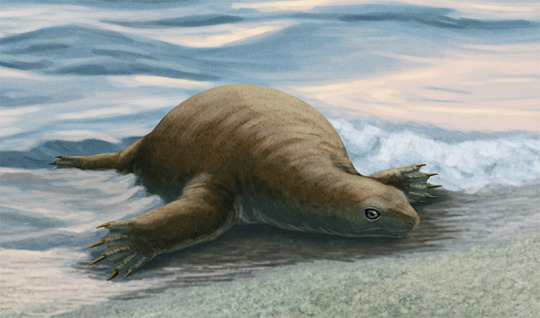
By @alphynix
Etymology: Toothed Turtle
First Described By: Lie et al., 2008
Classification: Biota, Archaea, Proteoarchaeota, Asgardarchaeota, Eukaryota, Neokaryota, Scotokaryota, Opimoda, Podiata, Amorphea, Obazoa, Opisthokonta, Holozoa, Filozoa, Choanozoa, Animalia, Eumetazoa, Parahoxozoa, Bilateria, Nephrozoa, Deuterostomia, Chordata, Olfactores, Vertebrata, Craniata, Gnathostomata, Eugnathostomata, Osteichthyes, Sarcopterygii, Rhipidistia, Tetrapodomorpha, Eotetrapodiformes, Elpistostegalia, Stegocephalia, Tetrapoda, Reptiliomorpha, Amniota, Sauropsida, Eureptilia, Romeriida, Diapsida, Neodiapsida, Sauria, Archosauromorpha?, Archelosauria, Pantestudines, Odontochelyidae
Time and Place: Around 232 million years ago, in the Carnian age of the Late Triassic
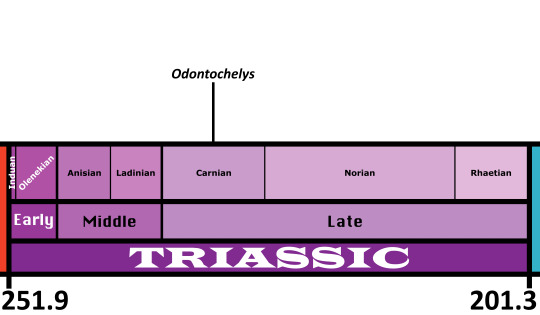
Odontochelys is known from the Lower Member of the Xiaowa Formation of China, commonly known as the Guanling Fauna
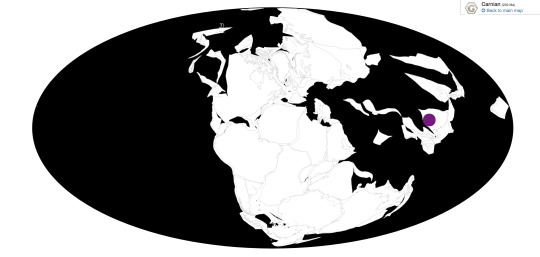
Physical Description: Odontochelys is one of the earliest known turtles - preceded by one, possibly two, precursors other than stem members of the family group - and it showcases how this extremely unique group managed to evolve in the chaos that was the Triassic Explosion. It was simultaneously similar to and very different from living turtles, a true transitional organism. Like other reptiles, it had teeth embedded in its jaws, rather than the toothless beak found in turtle mouths. Like turtles, it had the lower plastron extending from its ribs, but unlike living turtles it had no upper shell - instead, it just had widened ribs and no bony shell around its body. The ribs and the vertebrae were put together differently from modern turtles as well, and its skull was more stretched out compared to its living relatives. It didn’t have fused tail bones, and its scapulae were very different from living turtles. It had short limbs and long, thick fingers, as well as a decently sized shell. It was about forty centimeters long from snout to tail tip.
Diet: The diet of Odontochelys is fairly uncertain, despite us having its teeth; though they are small and peg like, we can’t really extrapolate a function since we don’t actually know its precise ecology! They may have been used for stripping plants, but it’s also possible they were used to chipp up algae and other aquatic water plants, or even invertebrates! So, more research there is clearly needed.
Behavior: The life history of Odontochelys is actually a big mystery. It was found in a marine environment, leading initial studies to indicate it was marine. However, it had the hands of a fresh water organism, including fresh water turtles today. Furthermore, studies of other early turtles indicate that turtles first arose on the land, rather than in the water, and later groups would adapt to water life; the limbs of Odontochelys share similarities with tortoises and support a terrestrial lifestyle. So, the ecology of Odontochelys has been a constant battle. That said, there is some evidence that it was actually marine - and may represent an early experiment in ocean life by turtles. One fossil of Odontochelys indicates that it had completely messed up shoulder bones, likely due to a problem in life rather than destruction of the fossil. This pattern resembles decompression sickness, aka the bends, aka the condition caused by a diving animal coming up much too fast from a lower depth. Modern turtles have complex behavioral adaptations to avoid the bends, so Odontochelys may be an early experiment in marine life in a group mostly adapted for terrestrial life. In this transition to ocean life, it not only lacked better physical adaptations for the ocean, but also better behavioral ones, and was stricken with the bends on its trip back to the surface. So, as we try to determine its ecology and behavior, these clued paint a rich tapestry of the world’s most transitional turtle. A pioneer!
Ecosystem: Odontochelys was found in - and thus, the null hypothesis is that it lived in - an ocean environment near the coast of the Tethys sea. This was a deep, open ocean - pelagic, hence the bends and problems Odontochelys faced trying to deal with the ocean. It was a very fertile ecosystem as well, with a variety of Triassic marine animals showcasing the rapid evolution of these groups. Among the invertebrates, there were many different types of Ammonites, plenty of bivalves, brachiopods, and crinoids & sea cucumbers as well. Still, the fascinating part of the ecosystem was the sheer number of marine reptiles. There were Thalattosaurs such as Anshusaurus and Xinpusaurus; Placodonts like Psephochelys and Sinocyamodus; and Ichthyosaurs like Qianicthyosaurus, Guizhouichthyosaurus, Guanlingsaurus, and Callawayia. One of many beautiful deposits of marine animals from this Period - and the many Ichthyosaurs would have been major predators of the relative n00b Odontochelys.
Other: Odontochelys also just looks really weird because it basically looks like your usual turtle except it doesn’t have a freaking shell so here we are with this oddity. It’s transitional in shape, transitional in ecology, transitional in behavior, and just. What the heck. What the heck, Odontochelys. If you need more proof for evolution despite knowing about the dinosaur - bird transition, have I got a friend for you.
~ By Meig Dickson
Sources Under the Cut
Anquetin, J. 2012. Reassessment of the phylogenetic interrelationships of basal turtles (Testudinata). Journal of Systematic Palaeontology 10(1):3-45.
Bradley Shaffer, H., E. McCartney-Melstad, T. J. Near, G. G. Mount, P. Q. Spinks. 2017. Phylogenomic analyses of 539 highly informative loci dates a fully resolved time tree for the major clades of living turtles (Testudines). Molecular Phylogenetics and Evolution 115: 7 - 15.
Feldmann, R. M., C. E. Schweitzer, S. Hu, J. Huang, Q. Zhang, C. Zhou, W. Wen, T. Xie, E. P. Maguire. 2017. A new Middle Triassic (Anisian) cyclidan crustacean from the Luoping Biota, Yunnan Province, China: morphologic and phylogenetic insights. Journal of Crustacean Biology 37 (4): 406 - 412.
Gilbert, S. F. 2007. How the turtle gets its shell. Biology of Turtles: The Structures to Strategies of Life.
Heiss, E. 2010. Functionality and plasticity of turtle-feeding with special emphasis on oropharyngeal structures. Universitat Wien Doctoral Dissertation.
Hess, H., W. Etter, and H. Hagdorn. 2016. Roveacrinida (Crinoidea) from Late Triassic (early Carnian) black shales of Southwest China. Swiss Journal of Paleontology 135(2):249-274.
Joyce, W. G. 2015. The origin of turtles: A paleontological perspective. Journal of Experimental Zoology Part B: Molecular and Developmental Evolution 324 (3): 181 - 193.
Lee, M. S. Y. 2013. Turtle origins: Insights from phylogenetic retrofitting and molecular scaffolds. Journal of Evolutionary Biology 26 (12): 2729 - 2738.
Lemell, P., N. Natchev, C. J. Beisser, E. Heiss. 2019. Feeding in Turtles: Understanding Terrestrial and Aquatic Feeding in a Diverse but Monophyletic Group. Feeding in Vertebrates: 611 - 642.
Li, C., and O. Rieppel. 2002. A new cyamodontid placodont from Triassic of Guizhou, China. Chinese Science Bulletin 47(5):403-407.
Li, C., X. C. Wu, O. Rieppel, L. T. Wang, and L. J. Zhao. 2008. An ancestral turtle from the Late Triassic of southwestern China. Nature 456:497-501.
Lu, H., D.-Y. Jiang, R. Motani, P.-G. Ni, Z.-Y. Sun, A. Tintori, S.-Z. Xiao, M. Zhou, C. Ji, W.-L. Fu. 2018. Middle Triassic Xingyi Fauna: Showing turnover of marine reptiles from coastal to oceanic environments. Palaeoworld 27 (1): 107 - 116.
Luo, M., Y.-M. Gong, G. R. Shi, Z.-Q. Chen, J. Huang, S. Hu, X. Feng, Q. Zhang, C. Zhou, W. Wen. 2018. Palaeoecological Analysis of Trace Fossil Sinusichnus sinuosus from the Middle Triassic Guanling Formationin Southwestern China. Journal of Earth Science 29: 854 - 863.
Meredith, R. W., J. Gatesy, M. S. Springer. Molecular decay of enamel matrix protein genes in turtles and other edentulous amniotes. BMC Evolutionary Biology 13: 20.
Neenan, J. M., N. Klein, T. M. Scheyer. 2013. European origin of placodont marine reptiles and the evolution of crushing dentition in Placodontia. Nature Communications 4: 1621.
Nicholls, E. L., C. Wei, and M. Manabe. 2002. New material of Qianichthyosaurus Li, 1999 (Reptilia, Ichthyosauria) from the Late Triassic of southern China, and implications for the distribution of Triassic icthyosaurs. Journal of Vertebrate Paleontology 22(4):759-765.
Reisz, R. R., J. J. Head. 2008. Palaeontology: Turtle origins out to sea. Nature 456 (7221): 450 - 451.
Rothschild, B. M., V. Naples. 2015. Decompression syndrome and diving behavior in Odontochelys, the first turtle. Acta Palaeontologica Polonica 60 (1): 163 - 167.
Schoch, R. R., H.-D. Sues. 2015. A Middle Triassic stem-turtle and the evolution of the turtle body plan. Nature 523 (7562): 584 - 587.
Shang, Q.-H., and C. Li. 2009. On the occurrence of the ichthyosaur Shastasaurus in the Guanling biota (Late Triassic), Guizhou, China. Vertebrata PalAsiatica 47(3):178-193.
Vermeij, G. J., R. Motani. 2017. Land to sea transitions in vertebrates: the dynamics of colonization. Paleobiology 44 (2): 237 - 250.
Wang, X., G. H. Bachmann, H. Hagdorn, P. M. Sanders, G. Cuny, X. Chen, C. Wang, L. Chen, L. Cheng, F. Meng, and G. Xu. 2008. The Late Triassic black shales of the Guanling area, Guizhou province, south-west China: a unique marine reptile and pelagic crinoid fossil lagerstätte. Palaeontology 51(1):27-61.
Wang, X., X. Chen, C. Wang, L. Cheng. 2009. The Triassic Guanling Fossil Group - A Key GeoPark from a barren mountain, Guizhou Province, China. Notebooks on Geology 3: Chapter 2: 11 - 28.
328 notes
·
View notes
Text
Update Time: Dinosaurs and Prehistoric Animals In Mass Media
A while back, I did a post on my findings for Dinosaur Representation in Film. Thanks to a project I’ve been aiding with, I’ve been able to greatly expand my media intact. From what I could watch (excluding the Simpsons, because how the hell am I gonna ID prehistoric life that cartoony), here are the top 10 prehistoric animals of various groups I’ve been able to log until about March of this year. Youtube always puts out something new, so I had to cut off some things. This covers Movies, TV Shows, Educational Shorts, Direct to Video productions, Youtube Channels, and Youtube videos (for not largely dedicated prehistoric channels/playlists). This involved a lot of IDing I had to do myself. So when a documentary showed a mural or sculpture, I did my best to either deduce or track down the thing so I could ID things properly. Crystal Palace and Age of Reptiles showed up a LOT. I even counted background skeletons for various museum shots when I could. Because I was going ALL IN on this. And things that used 60% stock footage were not counted to avoid repetition. That said, footage from The Lost World (1925) got used a LOT, like, into the 21st century even! As a final side note: SCREW Trilobites! They’re almost never IDed, and there are 40,000 of them! Here is what I found out:
Top 15 Dinosaurs:
Tyrannosaurus - 306
“Raptor” (Velociraptor (90), Deinonychus (91), and Dakotaraptor/Giant Movie Villain Raptor (56) combined) - 237
Triceratops - 223
Apatosaurus ((121) and Brontosaurus(99)) - 220
Stegosaurus - 181
Allosaurus - 164
Basic Ornithomimidae (Struthiomimus (48), Ornithomimus (42), Gallimimus (30), Dromiceiomimus (8), Pelicanimimus (5), Archaeornithomimus (1) Combined) - 134
Edmontosaurus/Anatosaurus/Anatotitan - 124
Brachiosaurus - 121
Parasaurolophus - 121
Ankylosaurus - 97
Diplodicus/Seismosaurus - 93
Iguanodon - 82
Pachycephalosaurus ((56), Stygimoloch (15), Dracorex (8), and Alaskacephale (1) combined) - 80
Coelophysis - 73
Top 10 Birds/Stem Birds/Avilalans
Archaeopteryx - 84
Hesperornis - 26
Giant Moa - 23
Titanis walleri - 22
Ichthyornis (and related) - 21
Gastornis - 20
Phorurhacos - 18
Confuciusornis - 18
Teratornis - 17
Haast’s Eagle - 15
Top 10 Non-Avian Line Archosaurs
Crocodiles, Alligators, Caiman (Lumped Together) - 32
Postosuchus - 31
Sarcosuchus - 26
Desmatosuchus - 25
Deinoschus - 22
Smilosuchus - 17
Rutiodon - 17
Erythrosuchus - 17
Teleosaurus - 15
Tanystropheus - 15
Top 15 Prehistoric Mammals
Woolly Mammoth - 99
Smilodon - 83
Neanderthals - 73
“Cave Man (Cro-Magnon) - 64
Australopithecus - 59
Columbian Mammoth - 41
Equus ferrus (wild horse/tarpan) - 37
Mastodon - 37
Megalonyx - 37
Homo erectus - 36
Woolly Rhino - 36
Glyptodon - 33
Megatheirum - 32
Dire Wolf - 31
Gigantopithecus (including Kong and knockoffs of Kong) - 31
Top 10 Synapsids
Dimetrodon - 81
Edaphosaurus - 30
Inostrancevia/Giant Gorgonopsids - 28
Gorgonops - 25
Diictodon - 23
Placerias - 22
Lystrosaurus - 21
Moschops - 16
Lisowicia - 15
Tie: Estemmenosuchus, Secodontosaurus, Sphenacodon - 14
Top 10 Ancient Lepisosaurs
Mosasaurus - 66
Megalania - 30 (I lumped many a Slurpasaurus in here)
Tylosaurus - 30
Titanoboa - 17
Prognathodon - 14
Gigantophis - 9
Plioplatecarpus - 9
Platecarpus - 8
Dallasaurus - 7
Tetrapodphis - 7
Regular Iguana’s come in at #11.
Top 15 Pterosaurs
Pteranodon - 153
Quetzalcoatlus - 87
Rhamphorhynchus - 55
Pterodactylus - 45
Dimorphodon - 38
Ornithocheirus - 25
Geosternbergia (was once considered a species of Pteranodon, but they are easy enough to distinguish) - 24
Anuragnathus - 24
Hatzegopteryx - 22
Nyctosaurus - 16
Eudimorphodon also has a 16, but I flipped a coin for this list.
Top 10 Ichthyosaurs
Ichthyosaurus - 37
Ophthalmosaurus - 26
Temnodontosaurus - 19
Sonisaurus - 15
Mixosaurus - 13
Shastasaurus - 10
Cymbospondylus - 9
Eurhinosaurus - 7
Stenopterygius - 7
Cartorhynchus - 7
Top 10 Other Aquatic Reptiles
Elasmosaurus - 64
Plesiosaurus - 47
Nothosaurus/”Paleosaurus” - 24
Pliosaurus - 19
Kronosaurus - 18
Liopleurodon - 16
Placodus - 12
Dolichorhynchops - 10
Cryptoclidus - 8
Placochelys - 7
Top 5 Turtles
Archelon - 21
Megalocheluys atlas/Giant Tortoises - 11
Proganocheys - 10
Odontochelys - 7
Carbonemys - 6
Top 5 Primitive Reptiles
Scutosaurus - 26
Hylomnus - 21
Drepanosaurus - 14
Mesosaurus - 10
Sharovipteryx - 9
Top ~10 Prehistoric Amphibians
Eryops - 38
Ichthyostega - 32
Tiktaalik - 23
Mastodonsaurus - 19
Koolasuchus - 16
Seymouria - 16
Metoposaurus - 15
Prionosuchus - 14
Platyhystrix - 14
Diplocaulus - 14
Acanthostega - 14
Crassigyrinus is just short of being in the grouping. Top 15 Fish and Sharks
Coelacanths (modern (23), Mawsonia (16), Coelacanthus (7), Rebellatrix (5), and Axelrodichthys (2)) - 53
Dunkleosteus - 32
Megalodon - 31
Lungfish (combined modern species and Necroceratodus) - 28
Xiphactinus - 26
Eusthenopteron - 26
Helicoprion - 24
Bothriolepis - 22
Onchopristis - 17
Orthacanthus - 17
Cretoxyrhina - 16
Hybodus - 16
Cheirolepis - 16
Cepjhalaspis - 15
Arandaspis - 14
Top 10 Arthropods & related.
Meganeura/Meganeuropsis - 59
Arthropleura - 27
Megalograptus - 26
Pterygotus - 24
Horeshoe Crab - 19
“Giant Spiders” - 18
Eurypterus - 18
Marella/Marellamorpha - 16
Pulmonoscorpius (Giant scorpion) - 14
Aysheaia - 12
Top 10 Trilobites
Generic Unnamed/Unidentified Trilobites - 38
Phacops - 24
REdlichia - 23
Isotelus rex - 20
Elrathia - 14
Dicranurus - 8
Asaphus - 8
Terataspis - 7
Olenoides - 7
Paradoxides - 7
If you don’t count the generic one, then the last slot is a tie for Harpes and Oryctocephalus (at 5 appearances each).
Top 10 Mollusks
Ammonite (Generic) (Identifying the various species of Ammonite by sight is as hard as the Trilobites) - 54
Cameroceras - 22
Belemnites - 20
Orthoceras - 16
Wiwazia 16
Nautilus - 15
Parapuzosia - 10
Clam - 10
Inoceramus - 9
Tusoteuthis/Giant Squid - 6
Top 9 Super-Primitive Basal Animals
Charnia - 20
Kimberella - 10
Dinomischus - 9
Amiskwia - 5
Ernietta - 5
Funisia - 5
Coronacollina - 4
Swartountia - 4
Cyclomedusa - 4
29 notes
·
View notes
Text
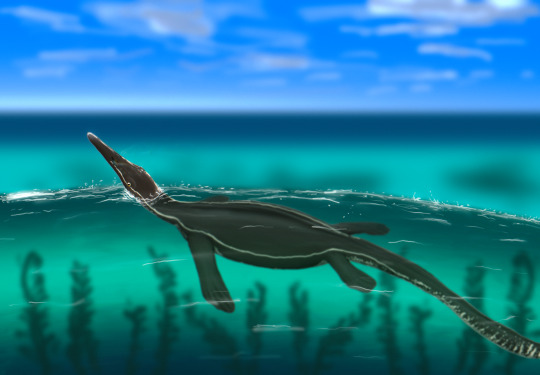
Baisesaurus vibing in the waves
So baisesaurus is a genus of ichthyosauromorph, related to ichthyosaurs and hupehsuchians and whatnot. The specimen itself is a few vertebrae, ribs and gastralia (iirc), so you can’t really tell the proportions. So what I did to reconstruct him is that I took hupehsuchians and basal ichthyosaur proportions and sorta mushed them together in a way that isn’t too far fetched and that I like
#paleoart#speculative biology#speculative evolution#art#paleontology#baisesaurus#ichthyosaur#ichthyosauromorph#hupehsuchians#paleoblr#sciart#waves#beach#sea#Triassic#mesozoic#artists on tumblr
41 notes
·
View notes
Photo

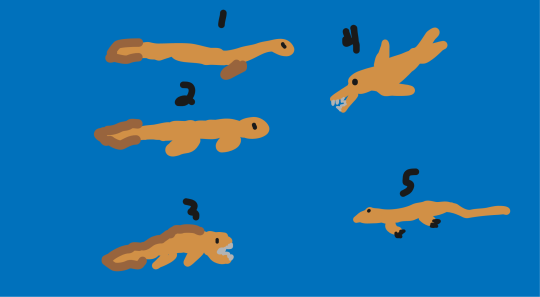
Tilerrasic 70-72 million years
The Tilerrasic marks the age of Saltiles and their ancestors the Terrestrial Hellbender and distant cousins the Cave Wyrms. The most successful Saltile which by this point has species all across the major continents except what remains of the Ratapolis Archipelago is the Notptor. In the dew-wood forests of Spriterra the continents apex predators the Red Rippers take down nearly any megafauna with their sophisticated pack hunting strategies.
And in the sea a new species of aquatic terrestrial hellbender exists,
Now known as Mosamanders this genus of aquatic and amphibious species. Like their ancestors they are still tied to the water to reproduce but this is not a problem for the Mosamanders as many of them are tied to the water, but some species still move on land thanks to their scales that help them keep moisture in.
1: A 8 foot long piscivore the Elsamomander resides in the oceans between the Sala and Manda continents with their main breeding ground being the Spriterra, With their long necks they snatch small to medium sized fish with needle like teeth.
2: A 4 foot long scavenger the Seabender is a basal aquatic terrestrial Hellbender that is the ancestor to most Mosamanders it trails Lurkers, bigger hellbenders, and krakenshoe crabs to snag a meal or clean their skin of parasites.
3: The Shellbender is a Mosamander that lurks along the seafloor and shallows in search of buried Free swimming horseshoe crabs and snails.
4: The most derived of the Mosamanders the Shamander is a Ichthyosaur like hunter that can reach lengths of 6 feet, hunting small krakenshoe crabs and other various small animals. It also is unique as due to the fact it can activate a reflex that allows it to hold its breath for up to an hour.
5: The only amphibious Mosamander the Saldile is a ambush predator that has take a crocodilian niche in rivers, swamps, and lakes. It also is the most intelligent with a brain comparable to a wild dog.
1 note
·
View note
Photo

Mixosaurus cornalianus here was a small early ichthyosaur, only about 0.8-1m long (2'7"-3'3") and generally considered to be transitional between the eel-like swimming style of basal forms and the more dolphin-like later forms. Living during the Middle Triassic, about 242 million years ago, it inhabited a shallow tropical sea that covered what is now the modern border between Switzerland and Italy.
It was previously thought to be a slow swimmer with a low and poorly-developed tail fin, and whether it even had a dorsal fin or not was unclear. But now new specimens with soft tissue impressions have given us a big surprise.
Not only did it actually have a fairly well-developed semilunate tail fin, but it also had a dorsal fin positioned much further forward on its body than expected, giving it a shape similar to some small sharks and representing the current earliest known dorsal fin of any amniote.
Bundles of stiffening collagen fibers inside its fins were very similar to those known from later Jurassic ichthyosaur species, indicating that this adaptation evolved much earlier in the lineage than previously thought. Along with stomach contents showing it mainly ate both cephalopods and small fish – fairly fast-moving prey – this suggests it was a capable open-water swimmer. It wouldn't have been quite as speedy as its much more specialized Jurassic relatives, but it may have still been about as efficient as the small modern sharks it resembled.
———
Nix Illustration | Tumblr | Pillowfort | Twitter | Patreon
#science illustration#paleontology#paleoart#palaeoblr#mixosaurus#mixosauridae#ichthyosaur#ichthyosauromorpha#reptile#marine reptiles#art#transitional forms#swimmy tail
213 notes
·
View notes
Text
Teraterpeton hrynewichorum

By @stolpergeist
Etymology: Wonderful creeping thing
First Described By: Sues, 2003
Classification: Biota, Archaea, Proteoarchaeota, Asgardarchaeota, Eukaryota, Neokaryota, Scotokaryota, Opimoda, Podiata, Amorphea, Obazoa, Opisthokonta, Holozoa, Filozoa, Choanozoa, Animalia, Eumetazoa, Parahoxozoa, Bilateria, Nephrozoa, Deuterostomia, Chordata, Olfactores, Vertebrata, Craniata, Gnathostomata, Eugnathostomata, Osteichthyes, Sarcopterygii, Rhipidistia, Tetrapodomorpha, Eotetrapodiformes, Elpistostegalia, Stegocephalia, Tetrapoda, Reptiliomorpha, Amniota, Sauropsida, Eureptilia, Romeriida, Diapsida, Neodiapsida, Sauria, Archosauromorpha, Crocopoda, Allokotosauria, Trilophosauridae
Status: Extinct
Time and Place: 237 to 227 million years ago, in the Carnian of the Late Triassic

Teraterpeton is known from Nova Scotia.

Physical Description: Teraterpeton was a bizarre archosauromorph. It is an allokotosaur, a member of a clade of relatively large herbivorous archosauromorphs. Some of them, including Teraterpeton, have snouts that lack teeth at the front, but have teeth posteriorly. These toothless regions may have been covered by a “beak” of sorts, similar to those that would evolve many times in ornithodirans. Teraterpeton stands out from its relatives because its snout is very long; about half of the skull would have been the front beak! The front of the upper and lower jaws are toothless and would have tapered to a narrow point anteriorly. The teeth, which were present further back in the jaw, were shaped so that the upper teeth formed a perfect contact with the lower teeth.
Further back on the skull, both the orbit and the nasal openings were large. Also interestingly, one of the temporal fenestrae at the back of the skull is closed. Most diapsids have two large holes in the back of the skull, upper and lower temporal fenestrae. In Teraterpeton, the lower temporal fenestra is closed. This “euryapsid” condition is also present in the marine ichthyosaurs and sauropterygians. Teraterpeton’s neck vertebrae Teraterpeton would have had moderately long legs and a sprawing gait. The claws on both the hands and feet were relatively large.
Diet: Teraterpeton was herbivorous; it likely used the beak at the front to snip off plant matter and used the posterior teeth to chew them up.
Behavior: Unfortunately, little is known about the behavior of allokotosaurs. The limbs were not well-suited for deep digging, but the large claws indicate that they may have been used to grab at something in the ground, such as exposed roots. Like the related Trilophosaurus, Teraterpeton probably grew relatively slowly, and may have had a lower metabolism than more derived archosauromorphs.
Ecosystem: The Wolfville Formation of Nova Scotia is a sandstone, indicating that Teraterpeton lived in a desert. It’s difficult identifying most of the skeletons from this area, as preservation is generally not great, but other creatures that lived in the area include the cynodont Arctotraversodon and the temnospondyl “Metoposaurus” bakeri.
Other: Allokotosaurs are a truly bizarre group of archosauromorphs. There are two main clades: Azendohsauridae, which includes Azendohsaurus, Malerisaurus, and Shringasaurus, and Trilophosauridae, which includes Teraterpeton, Trilophosaurus, Spinosuchus, Variodens, and three scrappy things from Russia that were first identified as procolophonids. There’s also the long-necked, insectivorous Pamelaria, which is just kind of its own thing.
~ By Henry Thomas
Sources under the cut
Marsh, A.D., Parker, W.G., Kligman, B.T., Lessner, E.J. 2017. Bonebed of a carnivorous archosauromorph from the Chinle Formation (Late Triassic: Norian) of Petrified Forest National PArk. GSA Annual Meeting, Seattle.
Pritchard, A.C., Sues, H.-D. 2019. Postcranial remains of Teraterpeton hrynewichorum (Reptilia: Archosauromorpha) and the mosaic evolution of the saurian postcranial skeleton. Journal of Systematic Palaeontology.
Sues, H.-D. 2003. An unusual new archosauromorph reptile from the Upper Triassic Wolfville Formation of Nova Scotia. Canadian Journal of Earth Sciences 40: 635-649.
Werning, S., Irmis, R. Reconstruction the ontogeny of the Triassic basal archosauromorph Trilophosaurus using bone histology and limb bone morphometrics. 70th Annual Meeting of the Society of Vertebate Paleontology, Pittsburgh.
#teraterpeton#allokotosaur#archosauromorph#triassic#triassic madness#triassic march madness#prehistoric life#paleontology
178 notes
·
View notes
Text
Atopodentatus unicus
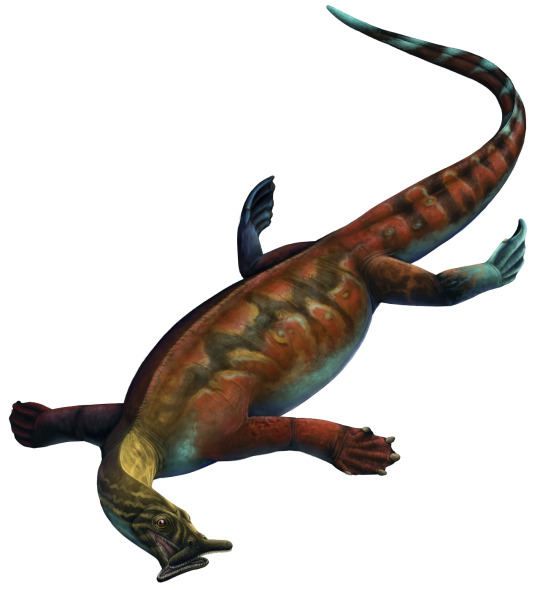
By Scott Reid
Etymology: Peculiar Teeth
First Described By: Cheng et al., 2014
Classification: Biota, Archaea, Proteoarchaeota, Asgardarchaeota, Eukaryota, Neokaryota, Scotokaryota Opimoda, Podiata, Amorphea, Obazoa, Opisthokonta, Holozoa, Filozoa, Choanozoa, Animalia, Eumetazoa, Parahoxozoa, Bilateria, Nephrozoa, Deuterostomia, Chordata, Olfactores, Vertebrata, Craniata, Gnathostomata, Eugnathostomata, Osteichthyes, Sarcopterygii, Rhipidistia, Tetrapodomorpha, Eotetrapodiformes, Elpistostegalia, Stegocephalia, Tetrapoda, Reptiliomorpha, Amniota, Sauropsida, Eureptilia, Romeriida, Disapsida, Neodiapsida, Sauria, Pantestudines, Sauropterygia
Referred Species: A. unicus
Status: Extinct
Time and Place: Sometime between 245 and 243 million years ago, in the Anisian of the Middle Triassic
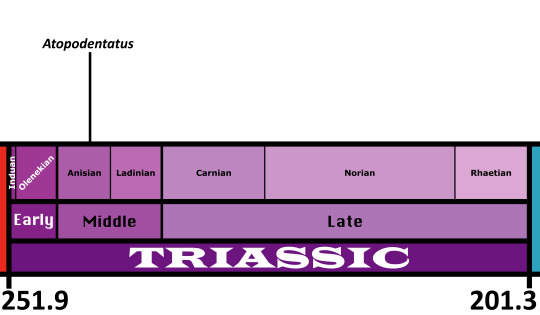
Atopodentatus is known from the Upper member of the Guanling Formation, in Yunnan, China
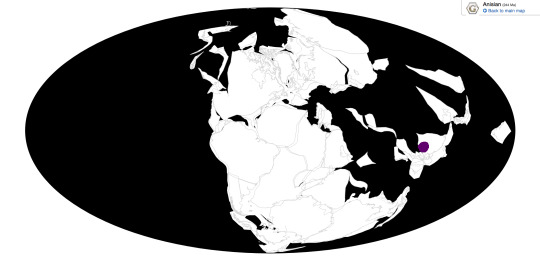
Physical Description: Atopodentatus is one of those Triassic weirdos that you just have to look at multiple times to understand what the heck is actually going on. It was a long and slender animal, reaching up to 3 meters in body length, with a noticeable tail and sleek torso. It had four long, paddle-like limbs, that were still noticeably arm and leg like as opposed to actual fins. It didn’t have much of a neck, which is striking since the rest of its body is so elongated; the neck ends in a proportionately fairly small head. It was so robust, it decidedly was an aquatic animal, and used this sleek body to maneuver through the water. The toes on the feet were probably covered with some sort of webbing or skin to help it paddle better through the water. Now, the weirdest part of Atopodentatus is decidedly its mouth - rather than having a normal mouth that ends in a normal shape like a normal animal, Atopodentatus has a weirdly wide mouth, sort of like a hammer-shape, with a bunch of chisel-shaped teeth in the front. In some ways, you could even call this a duck bill, but a very weird and comb like one. Honestly I have no descriptive words. You just have to look at it. As a marine reptile, it would have been covered in smooth scales, generally designed to help it move through the water.
Diet: Atopodentatus was an herbivore, but a filter feeding one! It would forage along the bottom of the seas and oceans, gathering up plant material into its mouth and using its teeth to filter out unwanted material and filter in the much needed weeds and greenery. It would manage to, then, stick to greenery such as algae and weeds and other aquatic plants, without eating hard stones or hard-shelled animals that wouldn’t have gone over well into its stomach. The wide mouth allowed it to gather in as much plant material as it could while it foraged along the sea floor.
Behavior: As a filter feeder, Atopodentatus would have spent much of its time grazing, sticking to shallow waters where the floor was filled with green plants and other food that it could eat. It probably would have moved its body from side to side, using its limbs to help move itself forward more forcefully and twisting its body to make turns. The tail would have also been helpful in moving, though we do not know to what extent and some marine reptiles would forgo the use of tails in underwater locomotion altogether. It probably didn’t go on land at all - not even to lay eggs - since it seems that turtles are the weirdos in terms of marine reptiles. Only turtles (and some other living marine reptiles) return to land to lay eggs; no other marine reptile seems to show this behavior, and most gave birth to live young - Ichthyosaurs, Mosasaurs, and Plesiosaurs. Atopodentatus does not seem to have adaptations for going back up onto land - it seems very highly adapted for aquatic life, and probably also gave birth to live young, though there isn’t much evidence either way in this regard. It is uncertain if it lived in groups, and it might have been a solitary grazer, rather than a family-oriented animal.
Ecosystem: Atopodentatus lived on the shores of the early Tethys Sea, as it began to grow during the Triassic as Pangea shifted from its former position. These habitats were mostly shallow water, where Atopodentatus could eat plants still able to grow with light from the sun such as algae and early sea weed like plants. It may have stayed close to the shore, then, to get more food, though that is just speculation. Many other marine reptiles and other Triassic animals are known from this general environment that lived alongside Atopodentatus. There were other Sauropterygians such as the Nothosaurs Dianopachysaurus and Lariosaurus; the Saurosphargids Sinosaurosphargis and Largocephalosaurus; and the mystery Sauropterygians Dianmeisaurus, Diandongosaurus and Panzhousaurus. There were also many Ichthyosauromorphs such as Mixosaurus, Xinminosaurus, Barracudasaurus, and Phalarodon. There was also Wumengosaurus, a weird marine reptile that could have been EITHER a Sauropterygian or an Ichthyosauromorph - or a bridge between the two? Fish were in abundance here as well. There were ray-finned fish such as the famed Saurichthys, Diadongperleidus, Luopingperleidus, Gymnoichthys, Yelangichthys, and Luoxiongichthys. Coelacanths were also represented by Yunnancoelacanthus and Luopingcoelacanthus. There were plenty of arthropods as well, including isopods like Protamphisopus, and zooplankton like Yunnanocopia. In short, a very diverse and active ecosystem, pumping out many new animals in the wake of the end-Permian extinction and showcasing the early diversification of marine reptiles.
Other: For a while, we thought Atopodentatus was weird in a different way - rather than having a duck-hammer-head, it was thought to have a head where the lower jaw curved into the upper jaw, which sloped downward, with many thin needle-like teeth packed together extremely tightly in the mouth. However, it turns out that the original skull was crushed, and the actual shape of the head is as we now know. Luckily, the rest of the body seems to have been fairly decently preserved, so the general body shape of Atopodentatus has not changed - just its ridiculous head.
The general sleek body with preliminary limbs adapted for aquatic life helps to place Atopodentatus in a group with other early marine reptiles, however this analysis is very basic and requires more support to firmly place this reptile in with other early marine reptiles of the Triassic. The Sauropterygians are a group of fairly mysterious creatures that include most of the famous marine reptiles that appeared in the Triassic; they may or may not have been closely related to turtles. As such, Atopodentatus would have been a fantastic early cousin of later weirdos like Plesiosaurus and Liopleurodon, though they wouldn’t stick with the shovel-filter-feeding mouth idea that Atopodentatus tried out. Still, it’s possible that the similarities found are just convergent evolution as many types of reptiles evolved to go back into the ocean and take advantage of new niches (jobs in the ecosystem) after the mass extinction; more work on the relationship of Atopodentatus to other early Triassic reptiles is, thus, needed.
Atopodentatus is the earliest known herbivorous marine reptile, preceding the next one in the fossil record by 8 million years - making its weirdness even more unique as the first experiment in plant eating in marine reptiles we know about!
~ By Meig Dickson
Sources Under the Cut
Cheng, L., X. H. Chen, X. W. Zeng, Y. J. Cai. 2012. A new eosauropterygian (Diapsida: Sauropterygia) from the Middle Triassic of Luoping, Yunnan Province. Journal of Earth Science 23 (1): 33 - 40.
Cheng, L.; Chen, X. H.; Shang, Q. H.; Wu, X. C. 2014. A new marine reptile from the Triassic of China, with a highly specialized feeding adaptation. Naturwissenschaften. 101 (3): 251–259.
Chun, L., O. Rieppel, C. Long and N. C. Fraser. 2016. The earliest herbivorous marine reptile and its remarkable jaw apparatus. Science Advances 2(5):e1501659.
Feldmann, R. M., C. E. Schweitzer, S. X. Hu, J. Y. Huang, C. Y. Zhou, Q. Y. Zhang, W. Wen, T. Xie, F. R. Schram and W. T. Jones. 2017. Earliest occurrence of lophogastrid mysidacean arthropods (Crustacea, Eucopiidae) from the Anisian Luoping Biota, Yunnan Province, China. Journal of Paleontology 91:100-115.
Fu, W. L., G. D. F. Wilson, D. Y. Yang, Y. L. Sun, W. C. Hao, Z. Y. Sun. 2010. A new species of Protamphisophus Nicholls (Crustacea, Isopoda, Phreatoicidea) from Middle Triassic Luoping Fauna of Yunnan Province, China. Journal of Paleontology 84 (5): 1003 - 1013.
Geng, B. H., F. Jin, F. X. Wu and Q. Wang. 2012. New perleidid fishes from the Middle Triassic strata of Yunnan Province. Geological Bulletin of China 31:915-927.
Ha, T. T. N., H. Takayanagi, K. Ueno, Y. Asahara, K. Yamamoto, Y. Iryu. 2019. Litho-, bio-, and chemostratigraphy of the Middle Triassic carbonate succession in the North-Central Coast region of Vietnam. Progress in Earth and Planetary Science 6: 47.
Jiang, D.-Y., W.-C. Hao, M. W. Maisch, A. T. Matzke, and Y.-L. Sun. 2005. A basal mixosaurid ichthyosaur from the Middle Triassic of China. Palaeontology 48(4):869-882
Jiang, D.-Y., M. W. Maisch, Z.-Y. Sun, Y.-L. Sun, and W.-C. Hao. 2006. A new species of Lariosaurus (Reptilia, Sauropterygia) from the Middle Anisian (Middle Triassic) of southwestern China. Neues Jahrbuch für Geologie und Paläontologie-Abhandlungen 242(1):19-42.
Jiang, D., R. Motani, W. Hao, L. Schmitz, O. Rieppel, Y. Sun, and Z. Sun. 2008. New primitive ichthyosaurian (Reptilia, Diapsida) from the Middle Triassic of Panxian, Guizhou, southwestern China and its position in the Triassic biotic recovery. Progress in Natural Science 18:1315-1319.
Jiang, D.-Y., W.-B. Lin, R. Motani and Z.-Y. Sun. 2018. A new Anisian (Middle Triassic) eosauropterygian (Reptilia, Sauropterygia) from Panzhou, Guizhou Province, China. Journal of Vertebrate Paleontology 38(4):1-9.
Li, C., O. Rieppel, X.-C. Wu, L.-J. Zhao, and L.-T. Wang. 2011. A new Triassic marine reptile from southwestern China. Journal of Vertebrate Paleontology 31(2):303-312.
Liu, J., J. Aitchison, Y.Y. Sun, Q. Y. Zhang, C.Y. Zhou and T. Lv. 2011. New Mixosaurid Ichthyosaur Specimen from the Middle Triassic of SW China: Further Evidence for the Diapsid Origin of Ichthyosaurs. Journal of Paleontology 85(1):32-36.
Liu, J., O. Rieppel, D.-Y. Jiang, J. C. Aitchison, R. Motani, Q.-Y. Zhang, C.-Y. Zhou and Y.-Y. Sun. 2011. A new pachypleurosaur (Reptilia: Sauropterygia) from the lower Middle Triassic of southwestern China and the phylogenetic relationships of Chinese pachypleurosaurs. Journal of Vertebrate Paleontology 31(2):292-302.
Liu, J., R. Motani, D. Jiang, S. Hu, J. C. Aitchison, O. Rieppel, M. J., Q. Zhang, and C. Zhou. 2013. The first specimen of the Middle Triassic Pharalodon atavus (Ichthyosauria: Mixosauridae) from South China, showing postcranial anatomy and peri-Tethyan distribution. Palaeontology.
Reynoso, V. H. 2000. An unusual aquatic sphenodontian (Reptilia: Diapsida) from the Tlayua Formation (Albian), central Mexico. Journal of Paleontology 74: 133 - 148.
Shang, Q.-H., X.-C. Wu, and C. Li. 2011. A new eosauropterygian from Middle Triassic of eastern Yunnan Province, southwestern China. Vertebrata PalAsiatica 49(2):155-171.
Shang, Q.-H., and C. Li. 2015. A new small-sized eosauropterygian (Diapsida: Sauropterygia) from the Middle Triassic of Luoping, Yunnan, southwestern China. Vertebrata PalAsiatica 53(4):265-280.
Sun, Z., A. Tintori, D. Jiang, C. Lombardo, M. Rusconi, W. Hao, and Y. Sun. 2009. A New Perleidiform (Actinopterygii, Osteichthyes) from the Middle Anisian (Middle Triassic) of Yunnan, South China. Acta Geologica Sinica 83(3):460-470.
Tan, K., and F. Jin. 2013. Re-study on Gymnoichthys inopinatus from Middle Triassic of Luoping, Yunnan, China. Vertebrata PalAsiatica 51:1-16.
Tintori, A., Z. Y. Sun, C. Lombardo, D. Y. Jiang, Y. L. Sun and W. C. Hao. 2010. A new basal neopterygian from the Middle Triassic of Luoping county (south China). Rivista Italiana di Paleontologia e Stratigrafia 116:161-172.
Wen, W., Q. Y. Zhang, C. Y. Zhou, J. Y. Huang, Z. Q. Chen and M. J. Benton. 2012. A new genus of basal actinopterygian fish from the Anisian (Middle Triassic) of Luoping, Yunnan Province, Southwest China. Acta Palaeontologica Polonica 57:149-160.
Wen, W., Q. Y. Zhang, S. X. Hu, M. J. Benton, C. Y. Zhou, X. Tao, J. Y. Huang and Z. Q. Chen. 2013. Coelacanths from the Middle Triassic Luoping Biota, Yunnan, South China, with the earliest evidence of ovoviviparity. Acta Palaeontologica Polonica 58:175-193.
Wu, F. X., M. M. Chang, Y. L. Sun and G. H. Xu. 2013. A new saurichthyiform (Actinopterygii) with a crushing feeding mechanism from the Middle Triassic of Guizhou (China). PLoS One 8(12):e81010.
Wu, F. X., Y. L. Sun, and G. Y. Fang. 2018. A new species of Saurichthys from the Middle Triassic (Anisian) of southwestern China. Vertebrata PalAsiatica 56:273-294.
#Atopodentatus#Atopodentatus unicus#Marine Reptile#Sauropterygian#Triassic#Palaeoblr#Reptile#Prehistoric Life#Prehistory#Paleontology#Triassic Madness#Triassic March Madness
244 notes
·
View notes